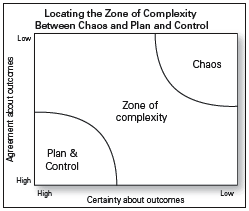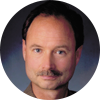The Zen master to the hot dog vendor: "Make me one with everything!"
The job of science is to pry knowledge from the cold, dead fingers of fear, dogma and belief.
It has been hard to argue with scientific results. In the 17th century, Galileo was condemned as a heretic for concluding that the Earth could not be at the center of the universe. He proposed a sun-centered model that endured for a couple of hundred years. In just the 20th century, we became comfortable with the idea that neither Earth nor our sun was the center of the universe. When Edwin Hubble announced in 1929 that the universe was "packed" with galaxies that were all moving rapidly away from each other, the shock waves made Earth even less central and life more improbable. By then, the Church had long since given up its position that the Earth was smack dab in the middle of infinity, and that all scientific inquiry had to first meet the constraints of belief before embarking upon discovery. The Church had a point: Infinity in every direction makes everything and everybody in the middle of the universe. But even if clergy had discovered that argument, it was way too late. Five hundred years had passed with horses of science galloping away from the corral of religion - too late to shut the gate.
Science and its application through technology have been a mixed blessing, as we know very well in health care, where birth, death and questions of infinity freely mingle. Today, there is an early momentum to yoke science and religion together to keep both of these enduring and endearing aspects of life contemporary, yet moral.
The scientific toolbox is full of clever and elegant tools to build and test theories over and over until some truth is eventually glimpsed. Science is not a single tool, nor is it one thing. There is good science and bad science. Science can be used to justify already-made-up minds. Science can be harnessed for healing or for killing. But all sciences seek to explain and predict.
One way science serves us is by making life less scary by explaining and predicting. In this sense, we are all scientists. When we hear about a friend or loved one with lung cancer, we demand to know, "Did she smoke?" With that question, we construct our own odds about mortality and the predictability of life. If she smoked, we are somehow relieved because we do not smoke - or may become more anxious because we do. All of us want to believe every outcome had its cause. It just seems so right for events not to happen without cause. The unexplained and unpredictable are attributed to "God's will," "fate" or "luck" - assigning a supernatural cause and effect. Science may reduce attribution to holy causes, but it does not diminish the possibility of original and ever-present cause. It is simply that God is not a testable hypothesis. Such a simple idea could save a lot of needless battling based on belief and principles.
I once heard an Oaxacan curandera lecture on her peculiar practice. Female curanderas and male curanderos have treated the indigenous Mexican population for thousands of years across Olmec, Toltec and Aztec cultures. Isolated from the influence of Western science and education, they evolved their own system of diagnosis and treatment. One patient came to her with grass growing out of his eyes. She immediately knew the cause and proclaimed, "You sneezed while looking at a snake!" She then prescribed an equally strange treatment commensurate with the diagnosis.
For those of us closer to a contemporary scientific lineage, we struggle to accommodate the curandera's perspective on disease and health. It is easy to find these extreme cases and dismiss them as delusions and quackery. Her approach is fascinating, if only because her perspective is so distinctly different. We might wonder how many of our own American patients are diagnosed within a narrow band of choices because of our own clinical habits and confidence. Most back pain I diagnosed was zygapophyseal. We may see a condition everywhere and all at once after a seminar; adrenal fatigue, for instance. We remember patients getting better when we treat them for this, and forget the ones who wander off. In fact, perhaps the curandera had a steady stream of "grassy-eyed" patients tramping through her office in various stages of the disease: latent, suspicious, comorbid, manifest, confirmed by tea leaves or, "Sorry, go home and put your affairs in order, your condition is beyond hope - too late even for Roundup weed killer."
A major purpose of science is to identify causes. When we consistently see a result from an action, we conclude that action causes the result or effect. With a high association between cause and effect, a high degree of confidence and agreement among perceivers results, and we take "command and control" of the situation, leaving nothing to doubt our ability to guide changes. Chance is no longer a factor. This predictable relationship between cause and effect is deterministic. Action A determines result R every time and without fail. A sure cure, if one existed, is an example. In the figure below, we see the "Plan and Control" corner on the bottom left, where agreement and certainty converge.
 As in any good boxing match, in the other corner is the enemy of Plan and Control. Meet Chaos, where people cannot agree on what to do or even on what they see. Inputs and outputs seem unrelated. In the Chaos corner, applying force or intentions is as unrelated to outcomes as the craps table in Las Vegas: Kiss the dice or not, fortune is not your servant. It is not even your friend.
As in any good boxing match, in the other corner is the enemy of Plan and Control. Meet Chaos, where people cannot agree on what to do or even on what they see. Inputs and outputs seem unrelated. In the Chaos corner, applying force or intentions is as unrelated to outcomes as the craps table in Las Vegas: Kiss the dice or not, fortune is not your servant. It is not even your friend.
And so it is that some take a stab at explaining what or how something worked (or did not) by alleging chaos was involved and the outcome can be "explained" by chaos theory. Not so fast. That is not an explanation. The especially large field between the two corners is the Zone of Complexity. Things that happen in this zone have features of chaos and certainty to various degrees. Life and everything else is complex and predictions about it are hit or miss. Health care performs in the Zone of Complexity. That is, inputs and outputs are related to each other with uncertainty. Our only hope of operating in the Zone of Complexity is to contain and minimize uncertainty in models of health and disease we build, and constantly update them with new information.
In the extreme corner of Chaos, nothing can be explained or predicted for certain. A "positive" outcome out of chaos is literally a miracle. And miracles have been embraced by some religions and condemned by most scientists for centuries.
For some reason, a chaos theory example that quickens hearts around the hookah is the Butterfly Effect, first presented at the December 1972 meeting of the American Association for the Advancement of Science in Washington, D.C., by Edward Lorenz. (And since, the title of a recent bad movie.) The idea of a butterfly in Brazil flapping one wing and causing a tornado in Texas seemed so urgent in the 1970s; everything is connected to everything else. But like bell bottoms, the idea is dated and no longer useful. Under a black light, set, setting and sound of sitar, the Butterfly Effect was astonishing.
Today, the butterfly has lost its effect. Why? We are surer of ourselves and our place in the universe. Like so many discoveries, we marvel until we understand it, and we discard it if not useful. The Butterfly Effect stands for the idea that any system has connections to everything else. Predictions are thus difficult in complex systems. Far out.
In science, the unexplained is called the residual. With science, we hope - soft word, to be sure - that in time and over time, research will lead us to predict more than we "residualize." This is the value of statistical science; in which we compare the amount and quality of the stuff we know to the amount and quality of stuff we do not know.
Healing can never be completely explained. Even a gene has a long way to go before breast cancer occurs. The best clinicians and scientists will recognize they work within the zone of complexity. I believe chiropractic care reduces health uncertainties. Otherwise, the profession would have been buried along with blood-letting and drinking mercury to cure syphilis. The science of chiropractic may be looking for significantly better, when equivalence will do: equivalent to surgery without the disability and costs; equivalent to prednisone without the fragile bones; equivalent to headache pills without the liver damage. Perhaps chiropractors will find their future in the residual, the unexplained.
Perhaps chiropractic scientists will embark on methods more appropriate to culling and accumulating chiropractic management evidence - rather than significant testing of spinal manipulation. Otherwise, we may try to explain things via the Butterfly Effect, which doesn't really explain anything.
Click here for previous articles by J. Michael Menke, MA, DC, PhD.





